 DE
DE- Industries
- Finance
Nearshore software development for finance—secure, scalable, and compliant solutions for banking, payments, and APIs.
- Retail
Retail software development services—e-commerce, POS, logistics, and AI-driven personalization from nearshore engineering teams.
- Manufacturing
Nearshore manufacturing software development—ERP systems, IoT platforms, and automation tools to optimize industrial operations.
- Finance
- What we do
- Services
- Software modernization services
- Cloud solutions
- AI – Artificial intelligence
- Idea validation & Product development services
- Digital solutions
- Integration for digital ecosystems
- A11y – Accessibility
- QA – Test development
- Technologies
- Front-end
- Back-end
- DevOps & CI/CD
- Cloud
- Mobile
- Collaboration models
- Collaboration models
Explore collaboration models customized to your specific needs: Complete nearshoring teams, Local heroes from partners with the nearshoring team, or Mixed tech teams with partners.
- Way of work
Through close collaboration with your business, we create customized solutions aligned with your specific requirements, resulting in sustainable outcomes.
- Collaboration models
- Services
- About Us
- Who we are
We are a full-service nearshoring provider for digital software products, uniquely positioned as a high-quality partner with native-speaking local experts, perfectly aligned with your business needs.
- Meet our team
ProductDock’s experienced team proficient in modern technologies and tools, boasts 15 years of successful projects, collaborating with prominent companies.
- Why nearshoring
Elevate your business efficiently with our premium full-service software development services that blend nearshore and local expertise to support you throughout your digital product journey.
- Who we are
- Our work
- Career
- Life at ProductDock
We’re all about fostering teamwork, creativity, and empowerment within our team of over 120 incredibly talented experts in modern technologies.
- Open positions
Do you enjoy working on exciting projects and feel rewarded when those efforts are successful? If so, we’d like you to join our team.
- Hiring guide
How we choose our crew members? We think of you as a member of our crew. We are happy to share our process with you!
- Rookie booth camp internship
Start your IT journey with Rookie boot camp, our paid internship program where students and graduates build skills, gain confidence, and get real-world experience.
- Life at ProductDock
- Newsroom
- News
Stay engaged with our most recent updates and releases, ensuring you are always up-to-date with the latest developments in the dynamic world of ProductDock.
- Events
Expand your expertise through networking with like-minded individuals and engaging in knowledge-sharing sessions at our upcoming events.
- News
- Blog
- Get in touch

08. Sep 2025 •4 minutes read
Best React libraries for fast development (2025 guide)
ProductDock
React remains the dominant JavaScript library used on over 52 million live websites worldwide.
As of 2025, choosing the right React libraries can be overwhelming, so this guide will highlight the best React libraries for fast development and productivity.
You’ll learn which tools accelerate UI development, state, forms, data fetching, and more, so you can ship production-ready features faster.
Top React libraries for fast development
Material‑UI (MUI)
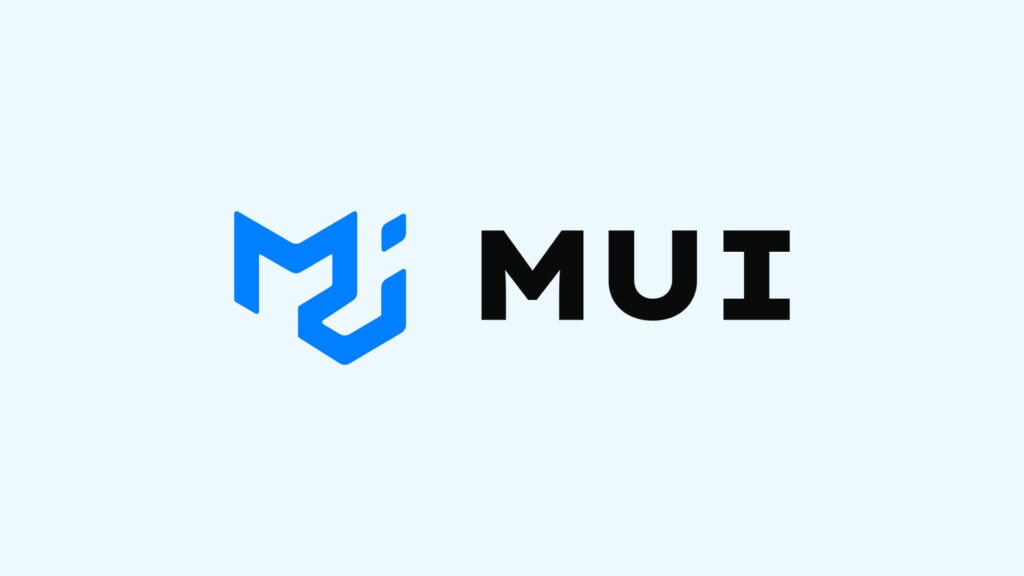
Material UI, also known as MUI, remains the gold standard for building modern, accessible, and responsive user interfaces in React. With over 3.3 million weekly downloads and 90k GitHub stars, MUI is trusted by startups and large enterprises alike. Its component library includes everything from buttons and forms to complex data grids, saving teams countless development hours.
Why developers love it: MUI enables fast prototyping without sacrificing design quality. Its theming system ensures brand consistency, and accessibility is built in, helping teams comply with standards like WCAG.
- What it is: A leading React UI toolkit with over 3.3 million weekly downloads and 90k+ GitHub stars by mid‑2025
- Why it’s fast: Offers ready-to-use, accessible components and built-in theming
- Drawbacks: Adds extra bundle size (~200 KB gzipped). The bundle size can be significantly reduced by avoiding barrel imports
- Best for: Dashboards & enterprise apps
- Dev-time savings: Builds UI faster than custom components
- Snippet:
import { Button } from '@mui/material';
<Button variant="contained">Save</Button>
Internal link: See ProductDock’s guide on React design systems.
Zustand

Zustand, meaning “state” in German, is a minimalistic state management library taking the React world by storm. With 2.8 million weekly downloads, it’s favored for its simplicity and zero-boilerplate setup. Unlike Redux or Context API, Zustand doesn’t require wrapping your app with providers or dealing with reducers.
Why developers love it: Zustand’s API is intuitive, its footprint is tiny, and its performance is unmatched for apps that need to scale state management efficiently. It’s ideal for projects where global state exists but complexity should be kept low.
- What it is: Minimal global state library with ~2.8 million weekly downloads, 49k+ GitHub stars
- Why it’s fast: Zero boilerplate, in-hook store, no provider needed
- Drawbacks: Less structure for large apps
- Best for: MVPs, small-to-mid apps
- Dev-time savings: Minimal setup, easy integration, and less boilerplate compared to Redux
- Snippet:
import create from 'zustand';
const useStore = create(set => ({ count: 0, inc: () => set(s => ({ count: s.count + 1 })) }));
React Hook Form

Managing forms in React can quickly become tedious, but React Hook Form simplifies the process with an elegant, performant approach. It boasts over 12.7 million weekly downloads, making it one of the most popular libraries in the React ecosystem.
Why developers love it: React Hook Form minimizes re-renders, handles validation easily, and works seamlessly with existing UI libraries. Its reliance on uncontrolled components improves performance, especially in large, complex forms.
- What it is: Popular form library – 12.7 million weekly downloads, zero dependencies
- Why it’s fast: Uses uncontrolled inputs to reduce re‑renders
- Drawbacks: Can get complex for dynamic forms
- Best for: Large form-heavy applications
- Dev-time savings: Forms built ~60% faster compared to controlled forms
- Snippet:
import { useForm } from 'react-hook-form';
const { register, handleSubmit } = useForm();
React Query
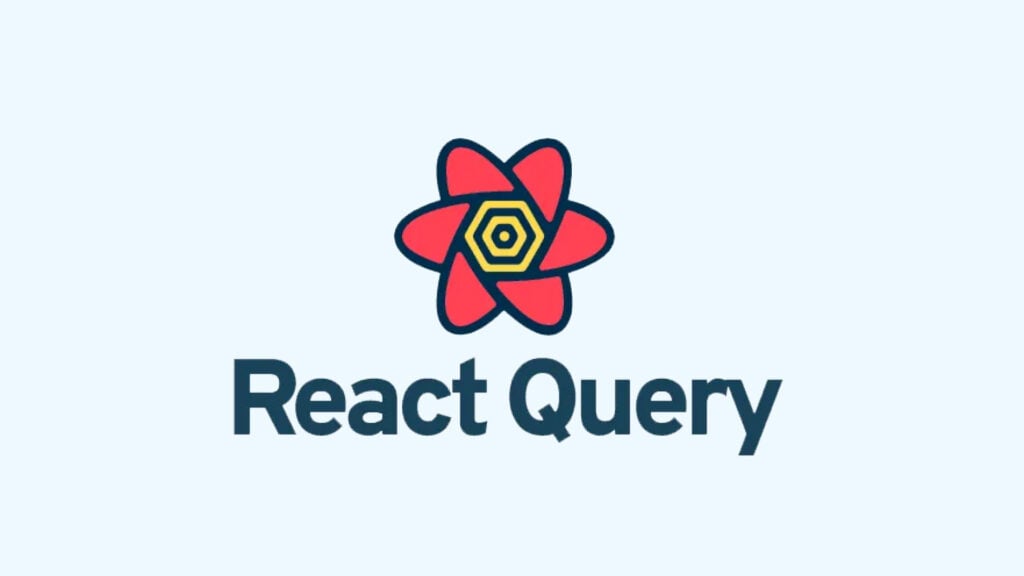
Fetching, caching, and synchronizing server data in React apps is often complex, but React Query, now part of TanStack, simplifies this task dramatically. With over 0.8 million weekly downloads, it’s a go-to solution for API-heavy apps.
Why developers love it: React Query abstracts away the hassles of data fetching, caching, background updates, and stale data management. It improves perceived performance, enhances UX, and reduces unnecessary network calls.
- What it is: TanStack’s data-fetching library with ~0.8 million weekly downloads, 43k GitHub stars
- Why it’s fast: Caching, background sync, stale-while-revalidate
- Drawbacks: Additional library and learning curve
- Best for: API-heavy apps
- Dev-time savings: Implements data logic ~30% faster
- Snippet:
import { useQuery } from '@tanstack/react-query';
const { data } = useQuery(['todos'], fetchTodos);
Radix UI
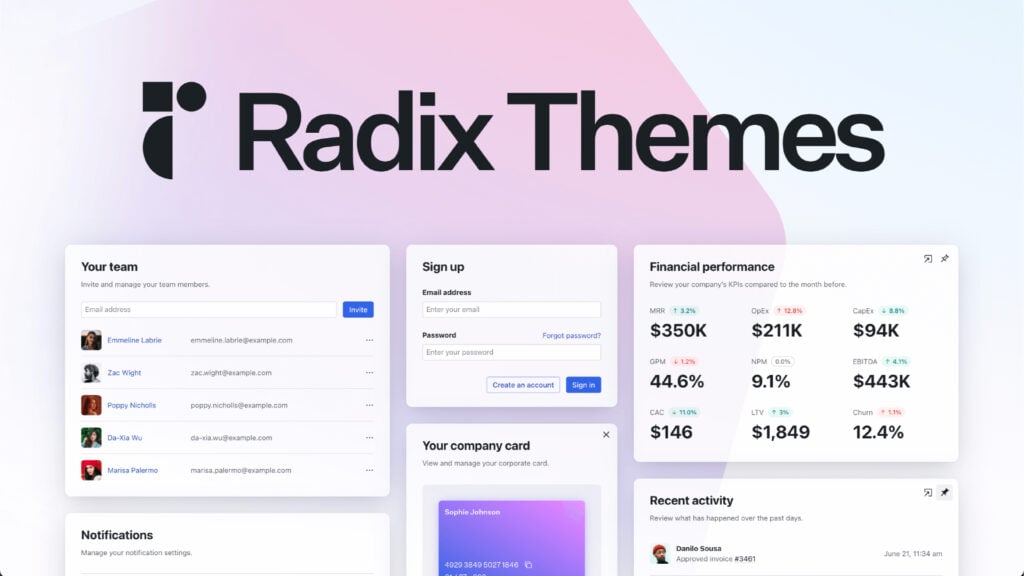
Radix UI is an open-source library providing accessible, unstyled UI primitives for React. It’s quickly gaining traction among teams building custom design systems with strict accessibility requirements.
Why developers love it: Radix UI offers complete control over styling while guaranteeing keyboard navigation, focus management, and screen-reader compatibility. Developers no longer have to trade off between speed and accessibility.
- What it is: Unstyled accessible primitives (e.g., toggle, dialog)
- Why it’s fast: Handles accessibility and keyboard behavior out-of-the-box
- Drawbacks: Requires manual styling
- Best for: Custom design systems with speed
- Dev-time savings: Accessibility implemented 50% faster
- Snippet:
import * as Toggle from '@radix-ui/react-toggle';
<Toggle.Root onPressedChange={...}>Toggle</Toggle.Root>
Next.js
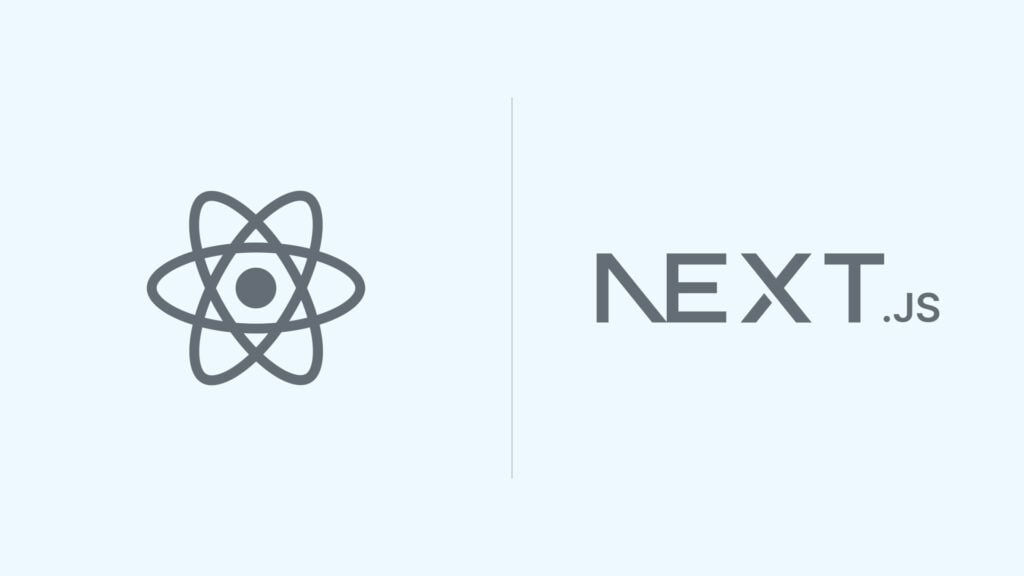
Next.js continues to dominate as the leading React framework for server-rendered and statically generated apps. With 6 million weekly downloads, its reputation for performance and scalability is well-earned.
Why developers love it: Next.js offers built-in routing, image optimization, server-side rendering (SSR), and static site generation (SSG). This combination delivers superior performance, SEO benefits, and faster load times, all with minimal configuration.
- What it is: React framework with SSR/SSG; ~6 million weekly downloads
- Why it’s fast: Offers server rendering, static optimization, built-in routing
- Drawbacks: Overkill for tiny apps
- Best for: SEO-sensitive, performance-first production apps
- Dev-time savings: Ships features ~35% faster with built-in tools
- Snippet:
export default function Page() { return <h1>Hello Next.js</h1>; }
Quick overview
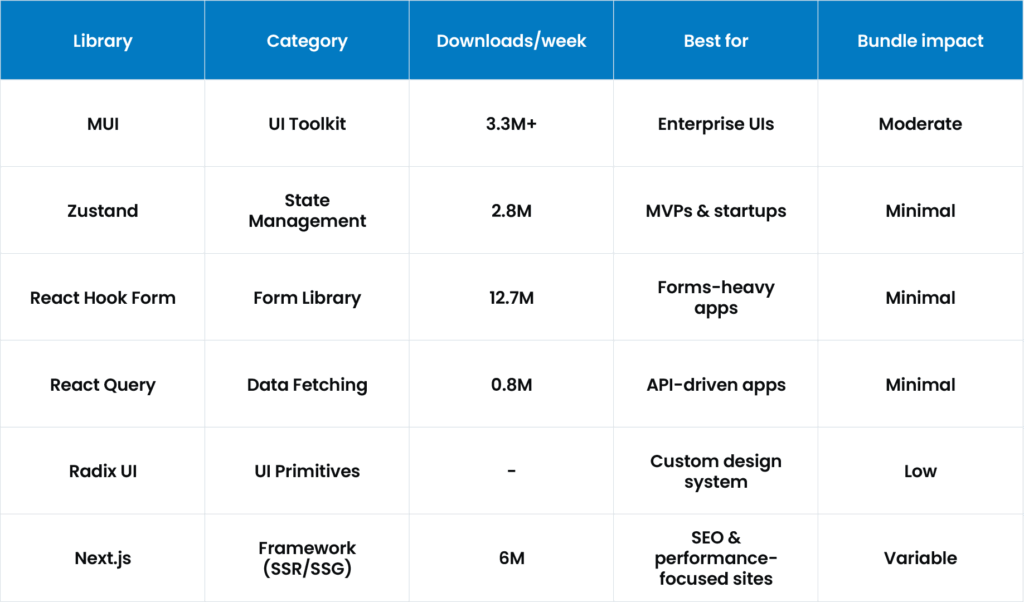
Frequently asked questions
Q1: What is the fastest state management library for React in 2025?
A: Zustand is extremely fast and lightweight. It requires no boilerplate or provider setup, making it ideal for rapid iteration and simple apps.
Q2: Is Material UI still relevant in 2025?
A: Yes. MUI remains a top choice for enterprise UIs, with ~3.3M weekly downloads and 94k stars due to its maturity and accessibility.
Q3: How can I optimize React forms for speed?
A: Use React Hook Form. It minimizes re-renders by managing inputs with refs instead of state.
Q4: What’s the advantage of Radix UI?
A: It offers accessible, unstyled components you can customize yourself, saving dev time while ensuring compliance.
Q5: Does Next.js improve React app performance?
A: Yes. Next.js offers SSR and static generation out-of-the-box, which significantly improves load speed and SEO.
Conclusion
In 2025, using the best React libraries for fast development, like MUI, Zustand, React Hook Form, React Query, Radix UI, and Next.js, can boost productivity by 30–60% while maintaining high performance.
By combining UI frameworks, lightweight state tools, optimized form handling, and data caching, developers can build robust apps fast.
Looking to accelerate your next React project?
Explore ProductDock’s services, and our experts can help you implement these tools efficiently. Reach out for a free assessment today.



